Analysis of Management Accounting Systems at O'Keefe Construction
VerifiedAdded on 2021/02/20
|21
|4778
|56
Report
AI Summary
This report delves into the realm of management accounting, using O'Keefe Construction Limited as a case study. It explores various management accounting systems such as price optimization, inventory management, cost accounting, and job costing, highlighting their significance in decision-making and financial reporting. The report outlines the preparation of management accounting reports, including inventory management reports, cost accounting reports, account receivable aging reports, and performance reports. Furthermore, it discusses the advantages of different management accounting systems and their integration within organizational processes. The report also provides a comparative analysis of costing techniques, specifically absorption costing and marginal costing, including the preparation of income statements using both methods, and interprets the impact of each method on the company's net profit. The report includes calculations and interpretations to support the analysis.

MANAGEMENT
ACCOUNTING
ACCOUNTING
Paraphrase This Document
Need a fresh take? Get an instant paraphrase of this document with our AI Paraphraser

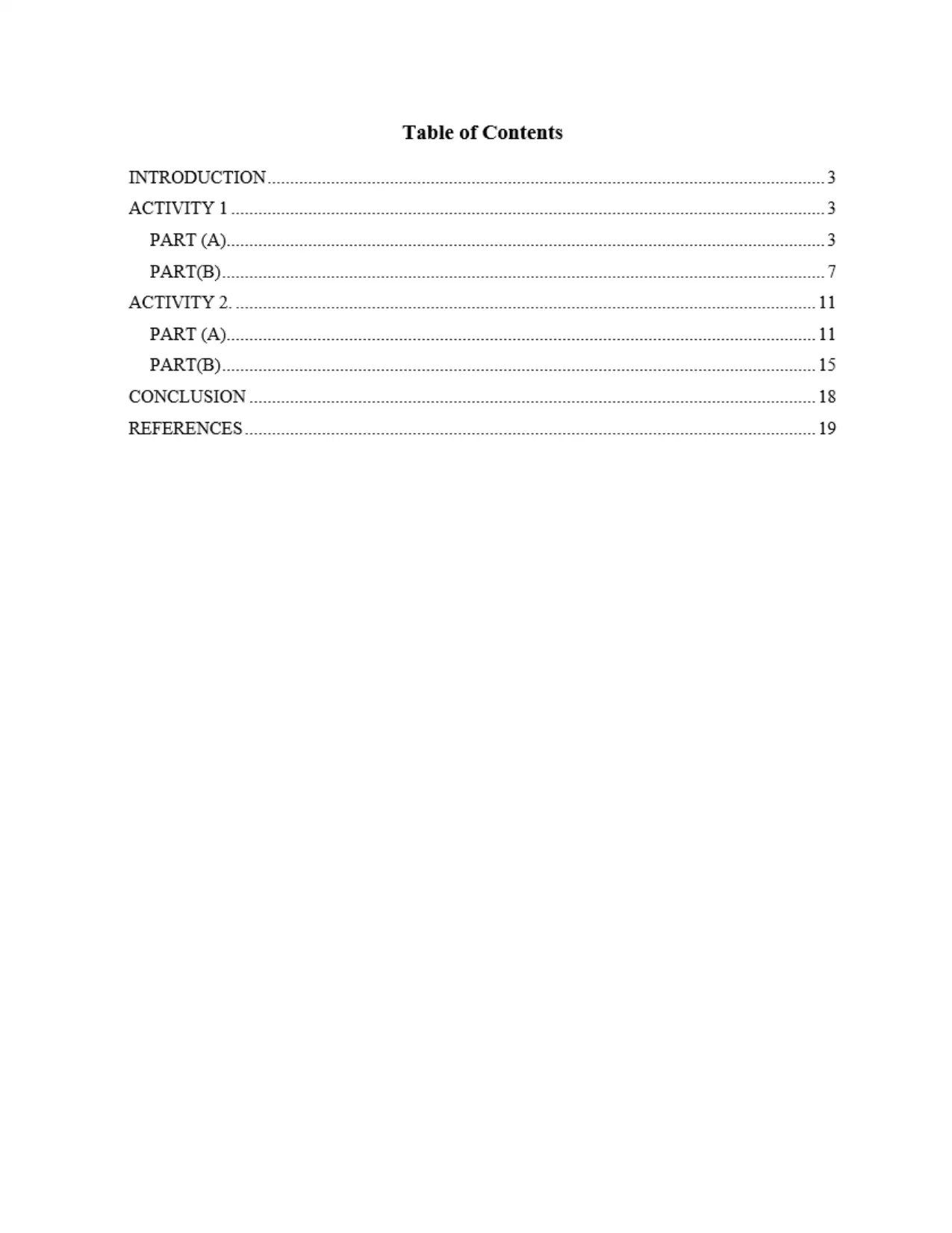
⊘ This is a preview!⊘
Do you want full access?
Subscribe today to unlock all pages.

Trusted by 1+ million students worldwide
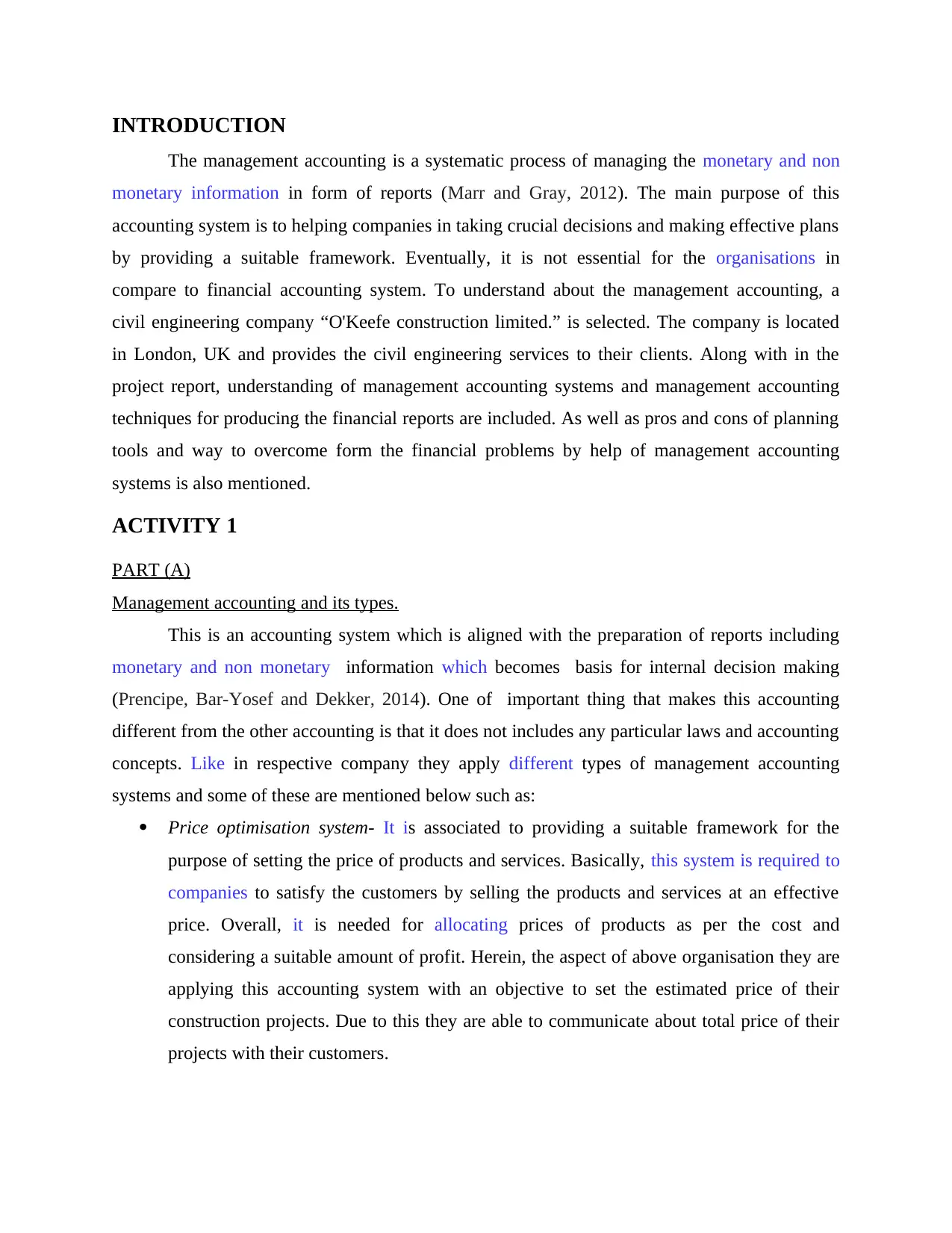
INTRODUCTION
The management accounting is a systematic process of managing the monetary and non
monetary information in form of reports (Marr and Gray, 2012). The main purpose of this
accounting system is to helping companies in taking crucial decisions and making effective plans
by providing a suitable framework. Eventually, it is not essential for the organisations in
compare to financial accounting system. To understand about the management accounting, a
civil engineering company “O'Keefe construction limited.” is selected. The company is located
in London, UK and provides the civil engineering services to their clients. Along with in the
project report, understanding of management accounting systems and management accounting
techniques for producing the financial reports are included. As well as pros and cons of planning
tools and way to overcome form the financial problems by help of management accounting
systems is also mentioned.
ACTIVITY 1
PART (A)
Management accounting and its types.
This is an accounting system which is aligned with the preparation of reports including
monetary and non monetary information which becomes basis for internal decision making
(Prencipe, Bar-Yosef and Dekker, 2014). One of important thing that makes this accounting
different from the other accounting is that it does not includes any particular laws and accounting
concepts. Like in respective company they apply different types of management accounting
systems and some of these are mentioned below such as:
Price optimisation system- It is associated to providing a suitable framework for the
purpose of setting the price of products and services. Basically, this system is required to
companies to satisfy the customers by selling the products and services at an effective
price. Overall, it is needed for allocating prices of products as per the cost and
considering a suitable amount of profit. Herein, the aspect of above organisation they are
applying this accounting system with an objective to set the estimated price of their
construction projects. Due to this they are able to communicate about total price of their
projects with their customers.
The management accounting is a systematic process of managing the monetary and non
monetary information in form of reports (Marr and Gray, 2012). The main purpose of this
accounting system is to helping companies in taking crucial decisions and making effective plans
by providing a suitable framework. Eventually, it is not essential for the organisations in
compare to financial accounting system. To understand about the management accounting, a
civil engineering company “O'Keefe construction limited.” is selected. The company is located
in London, UK and provides the civil engineering services to their clients. Along with in the
project report, understanding of management accounting systems and management accounting
techniques for producing the financial reports are included. As well as pros and cons of planning
tools and way to overcome form the financial problems by help of management accounting
systems is also mentioned.
ACTIVITY 1
PART (A)
Management accounting and its types.
This is an accounting system which is aligned with the preparation of reports including
monetary and non monetary information which becomes basis for internal decision making
(Prencipe, Bar-Yosef and Dekker, 2014). One of important thing that makes this accounting
different from the other accounting is that it does not includes any particular laws and accounting
concepts. Like in respective company they apply different types of management accounting
systems and some of these are mentioned below such as:
Price optimisation system- It is associated to providing a suitable framework for the
purpose of setting the price of products and services. Basically, this system is required to
companies to satisfy the customers by selling the products and services at an effective
price. Overall, it is needed for allocating prices of products as per the cost and
considering a suitable amount of profit. Herein, the aspect of above organisation they are
applying this accounting system with an objective to set the estimated price of their
construction projects. Due to this they are able to communicate about total price of their
projects with their customers.
Paraphrase This Document
Need a fresh take? Get an instant paraphrase of this document with our AI Paraphraser
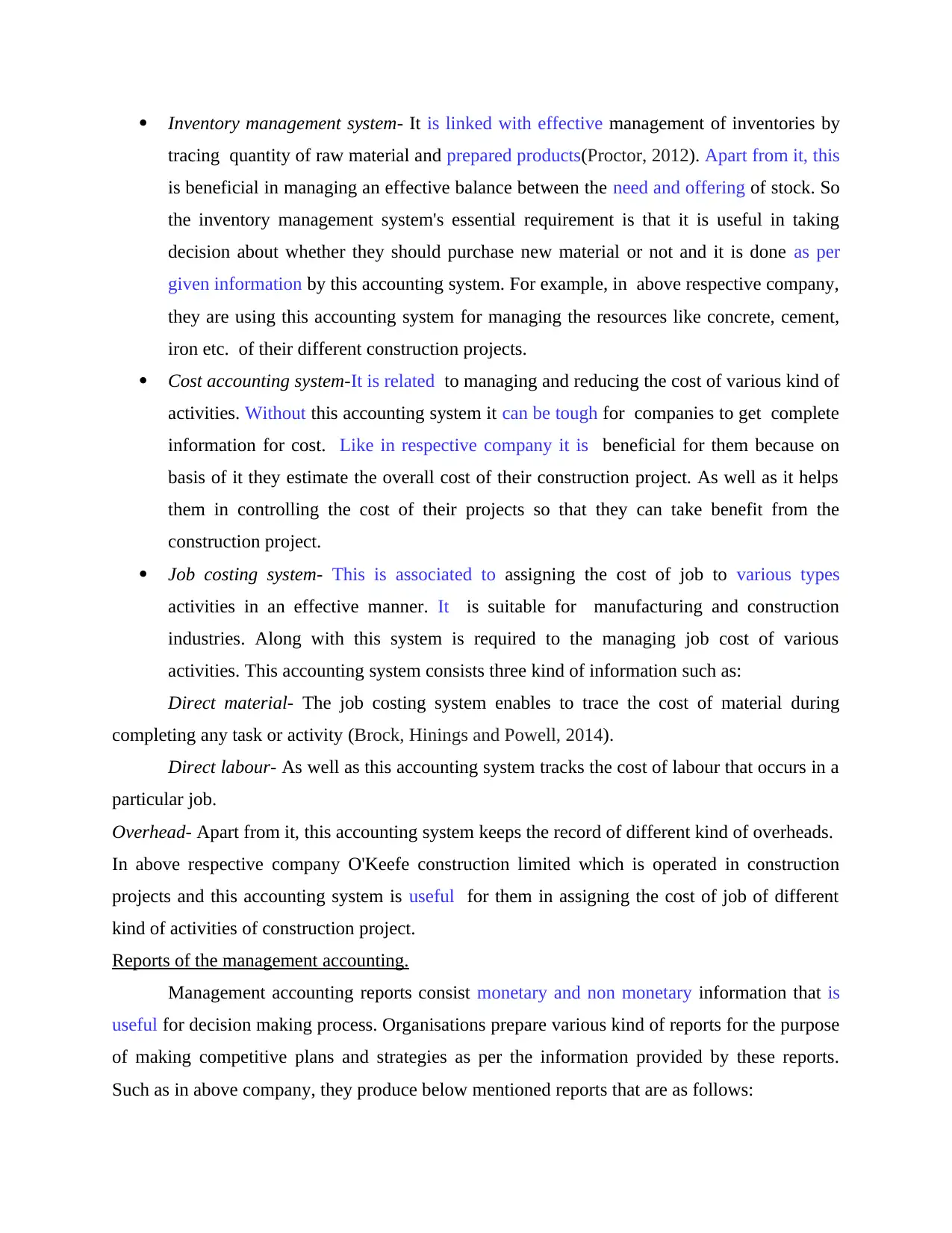
Inventory management system- It is linked with effective management of inventories by
tracing quantity of raw material and prepared products(Proctor, 2012). Apart from it, this
is beneficial in managing an effective balance between the need and offering of stock. So
the inventory management system's essential requirement is that it is useful in taking
decision about whether they should purchase new material or not and it is done as per
given information by this accounting system. For example, in above respective company,
they are using this accounting system for managing the resources like concrete, cement,
iron etc. of their different construction projects.
Cost accounting system-It is related to managing and reducing the cost of various kind of
activities. Without this accounting system it can be tough for companies to get complete
information for cost. Like in respective company it is beneficial for them because on
basis of it they estimate the overall cost of their construction project. As well as it helps
them in controlling the cost of their projects so that they can take benefit from the
construction project.
Job costing system- This is associated to assigning the cost of job to various types
activities in an effective manner. It is suitable for manufacturing and construction
industries. Along with this system is required to the managing job cost of various
activities. This accounting system consists three kind of information such as:
Direct material- The job costing system enables to trace the cost of material during
completing any task or activity (Brock, Hinings and Powell, 2014).
Direct labour- As well as this accounting system tracks the cost of labour that occurs in a
particular job.
Overhead- Apart from it, this accounting system keeps the record of different kind of overheads.
In above respective company O'Keefe construction limited which is operated in construction
projects and this accounting system is useful for them in assigning the cost of job of different
kind of activities of construction project.
Reports of the management accounting.
Management accounting reports consist monetary and non monetary information that is
useful for decision making process. Organisations prepare various kind of reports for the purpose
of making competitive plans and strategies as per the information provided by these reports.
Such as in above company, they produce below mentioned reports that are as follows:
tracing quantity of raw material and prepared products(Proctor, 2012). Apart from it, this
is beneficial in managing an effective balance between the need and offering of stock. So
the inventory management system's essential requirement is that it is useful in taking
decision about whether they should purchase new material or not and it is done as per
given information by this accounting system. For example, in above respective company,
they are using this accounting system for managing the resources like concrete, cement,
iron etc. of their different construction projects.
Cost accounting system-It is related to managing and reducing the cost of various kind of
activities. Without this accounting system it can be tough for companies to get complete
information for cost. Like in respective company it is beneficial for them because on
basis of it they estimate the overall cost of their construction project. As well as it helps
them in controlling the cost of their projects so that they can take benefit from the
construction project.
Job costing system- This is associated to assigning the cost of job to various types
activities in an effective manner. It is suitable for manufacturing and construction
industries. Along with this system is required to the managing job cost of various
activities. This accounting system consists three kind of information such as:
Direct material- The job costing system enables to trace the cost of material during
completing any task or activity (Brock, Hinings and Powell, 2014).
Direct labour- As well as this accounting system tracks the cost of labour that occurs in a
particular job.
Overhead- Apart from it, this accounting system keeps the record of different kind of overheads.
In above respective company O'Keefe construction limited which is operated in construction
projects and this accounting system is useful for them in assigning the cost of job of different
kind of activities of construction project.
Reports of the management accounting.
Management accounting reports consist monetary and non monetary information that is
useful for decision making process. Organisations prepare various kind of reports for the purpose
of making competitive plans and strategies as per the information provided by these reports.
Such as in above company, they produce below mentioned reports that are as follows:
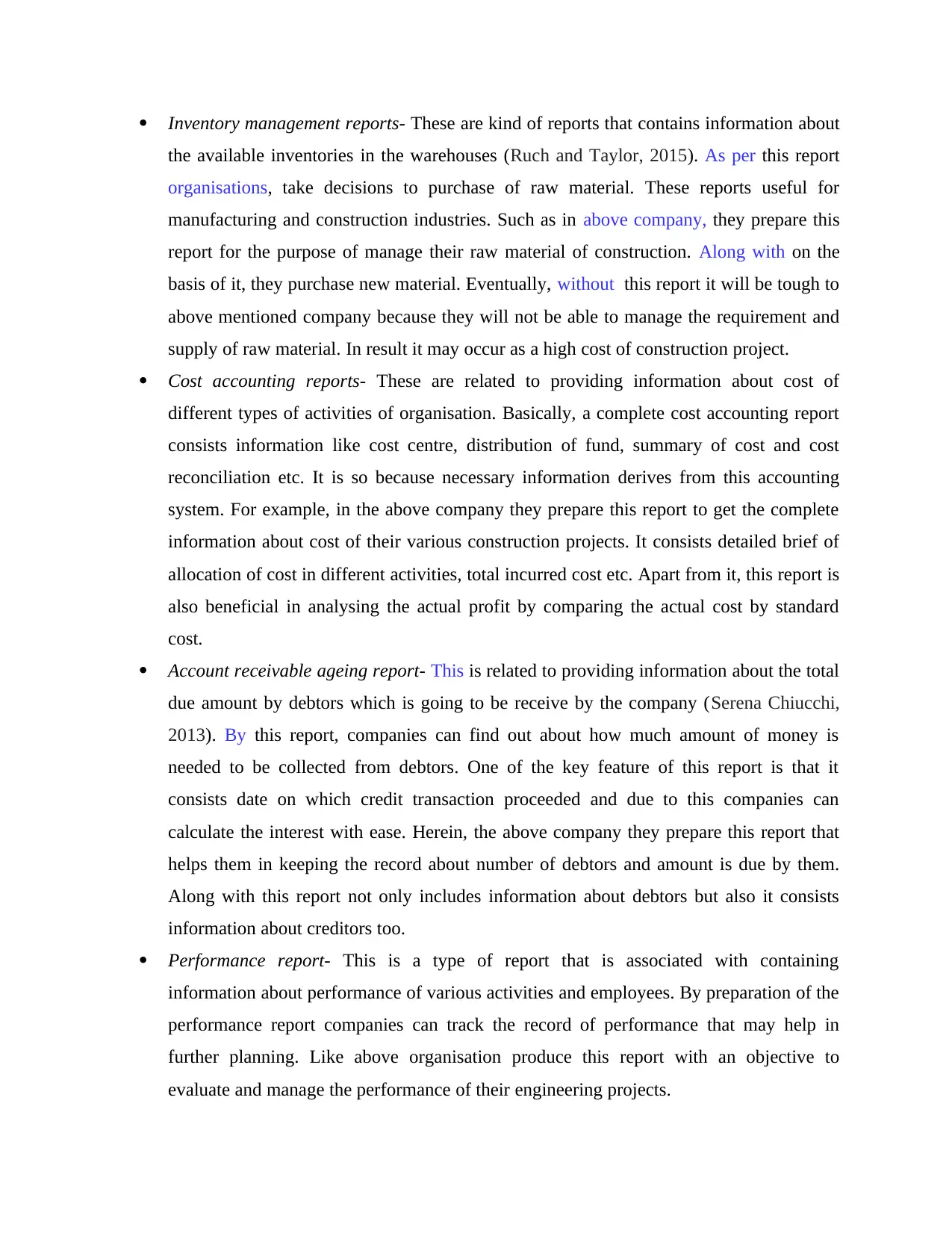
Inventory management reports- These are kind of reports that contains information about
the available inventories in the warehouses (Ruch and Taylor, 2015). As per this report
organisations, take decisions to purchase of raw material. These reports useful for
manufacturing and construction industries. Such as in above company, they prepare this
report for the purpose of manage their raw material of construction. Along with on the
basis of it, they purchase new material. Eventually, without this report it will be tough to
above mentioned company because they will not be able to manage the requirement and
supply of raw material. In result it may occur as a high cost of construction project.
Cost accounting reports- These are related to providing information about cost of
different types of activities of organisation. Basically, a complete cost accounting report
consists information like cost centre, distribution of fund, summary of cost and cost
reconciliation etc. It is so because necessary information derives from this accounting
system. For example, in the above company they prepare this report to get the complete
information about cost of their various construction projects. It consists detailed brief of
allocation of cost in different activities, total incurred cost etc. Apart from it, this report is
also beneficial in analysing the actual profit by comparing the actual cost by standard
cost.
Account receivable ageing report- This is related to providing information about the total
due amount by debtors which is going to be receive by the company (Serena Chiucchi,
2013). By this report, companies can find out about how much amount of money is
needed to be collected from debtors. One of the key feature of this report is that it
consists date on which credit transaction proceeded and due to this companies can
calculate the interest with ease. Herein, the above company they prepare this report that
helps them in keeping the record about number of debtors and amount is due by them.
Along with this report not only includes information about debtors but also it consists
information about creditors too.
Performance report- This is a type of report that is associated with containing
information about performance of various activities and employees. By preparation of the
performance report companies can track the record of performance that may help in
further planning. Like above organisation produce this report with an objective to
evaluate and manage the performance of their engineering projects.
the available inventories in the warehouses (Ruch and Taylor, 2015). As per this report
organisations, take decisions to purchase of raw material. These reports useful for
manufacturing and construction industries. Such as in above company, they prepare this
report for the purpose of manage their raw material of construction. Along with on the
basis of it, they purchase new material. Eventually, without this report it will be tough to
above mentioned company because they will not be able to manage the requirement and
supply of raw material. In result it may occur as a high cost of construction project.
Cost accounting reports- These are related to providing information about cost of
different types of activities of organisation. Basically, a complete cost accounting report
consists information like cost centre, distribution of fund, summary of cost and cost
reconciliation etc. It is so because necessary information derives from this accounting
system. For example, in the above company they prepare this report to get the complete
information about cost of their various construction projects. It consists detailed brief of
allocation of cost in different activities, total incurred cost etc. Apart from it, this report is
also beneficial in analysing the actual profit by comparing the actual cost by standard
cost.
Account receivable ageing report- This is related to providing information about the total
due amount by debtors which is going to be receive by the company (Serena Chiucchi,
2013). By this report, companies can find out about how much amount of money is
needed to be collected from debtors. One of the key feature of this report is that it
consists date on which credit transaction proceeded and due to this companies can
calculate the interest with ease. Herein, the above company they prepare this report that
helps them in keeping the record about number of debtors and amount is due by them.
Along with this report not only includes information about debtors but also it consists
information about creditors too.
Performance report- This is a type of report that is associated with containing
information about performance of various activities and employees. By preparation of the
performance report companies can track the record of performance that may help in
further planning. Like above organisation produce this report with an objective to
evaluate and manage the performance of their engineering projects.
⊘ This is a preview!⊘
Do you want full access?
Subscribe today to unlock all pages.

Trusted by 1+ million students worldwide
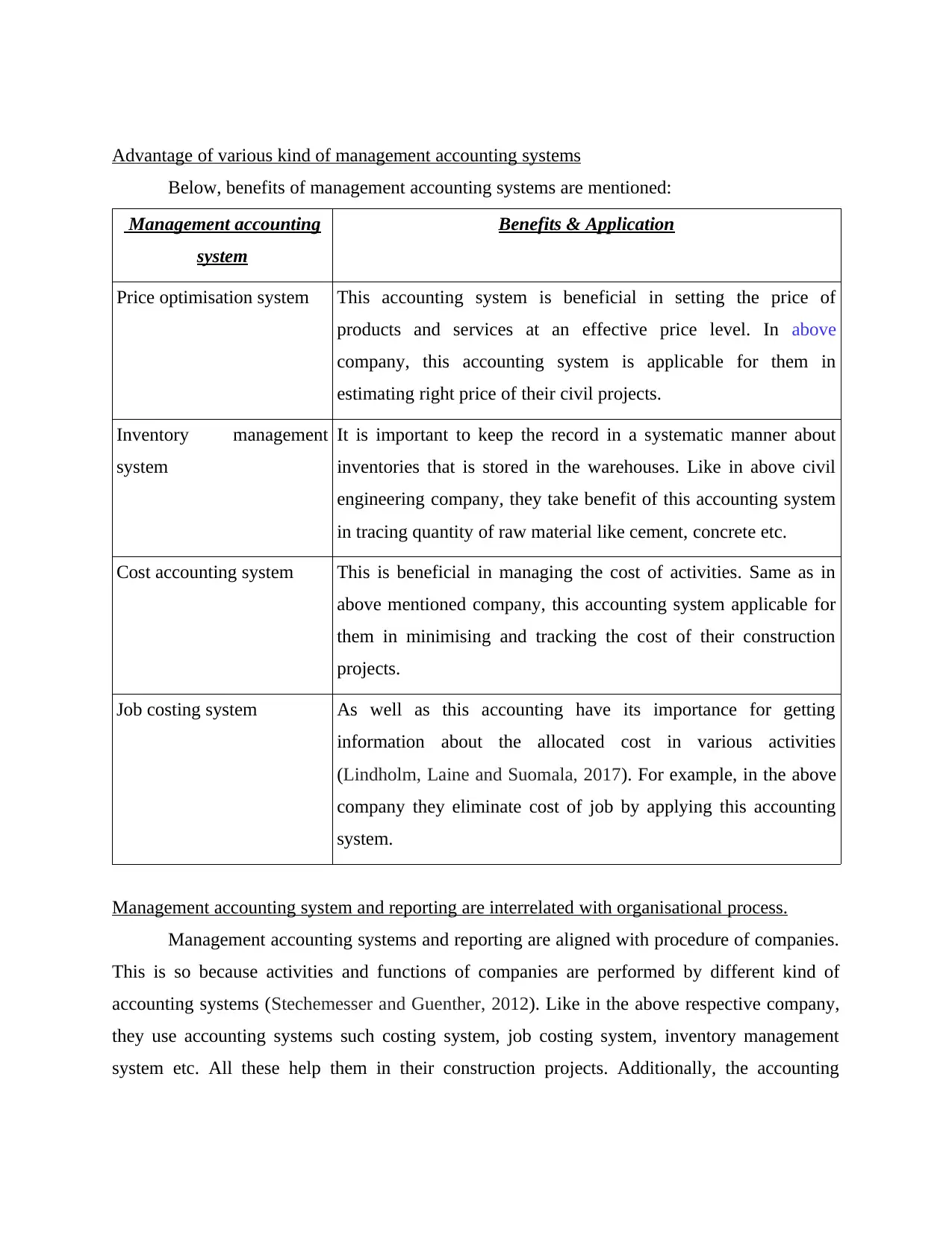
Advantage of various kind of management accounting systems
Below, benefits of management accounting systems are mentioned:
Management accounting
system
Benefits & Application
Price optimisation system This accounting system is beneficial in setting the price of
products and services at an effective price level. In above
company, this accounting system is applicable for them in
estimating right price of their civil projects.
Inventory management
system
It is important to keep the record in a systematic manner about
inventories that is stored in the warehouses. Like in above civil
engineering company, they take benefit of this accounting system
in tracing quantity of raw material like cement, concrete etc.
Cost accounting system This is beneficial in managing the cost of activities. Same as in
above mentioned company, this accounting system applicable for
them in minimising and tracking the cost of their construction
projects.
Job costing system As well as this accounting have its importance for getting
information about the allocated cost in various activities
(Lindholm, Laine and Suomala, 2017). For example, in the above
company they eliminate cost of job by applying this accounting
system.
Management accounting system and reporting are interrelated with organisational process.
Management accounting systems and reporting are aligned with procedure of companies.
This is so because activities and functions of companies are performed by different kind of
accounting systems (Stechemesser and Guenther, 2012). Like in the above respective company,
they use accounting systems such costing system, job costing system, inventory management
system etc. All these help them in their construction projects. Additionally, the accounting
Below, benefits of management accounting systems are mentioned:
Management accounting
system
Benefits & Application
Price optimisation system This accounting system is beneficial in setting the price of
products and services at an effective price level. In above
company, this accounting system is applicable for them in
estimating right price of their civil projects.
Inventory management
system
It is important to keep the record in a systematic manner about
inventories that is stored in the warehouses. Like in above civil
engineering company, they take benefit of this accounting system
in tracing quantity of raw material like cement, concrete etc.
Cost accounting system This is beneficial in managing the cost of activities. Same as in
above mentioned company, this accounting system applicable for
them in minimising and tracking the cost of their construction
projects.
Job costing system As well as this accounting have its importance for getting
information about the allocated cost in various activities
(Lindholm, Laine and Suomala, 2017). For example, in the above
company they eliminate cost of job by applying this accounting
system.
Management accounting system and reporting are interrelated with organisational process.
Management accounting systems and reporting are aligned with procedure of companies.
This is so because activities and functions of companies are performed by different kind of
accounting systems (Stechemesser and Guenther, 2012). Like in the above respective company,
they use accounting systems such costing system, job costing system, inventory management
system etc. All these help them in their construction projects. Additionally, the accounting
Paraphrase This Document
Need a fresh take? Get an instant paraphrase of this document with our AI Paraphraser
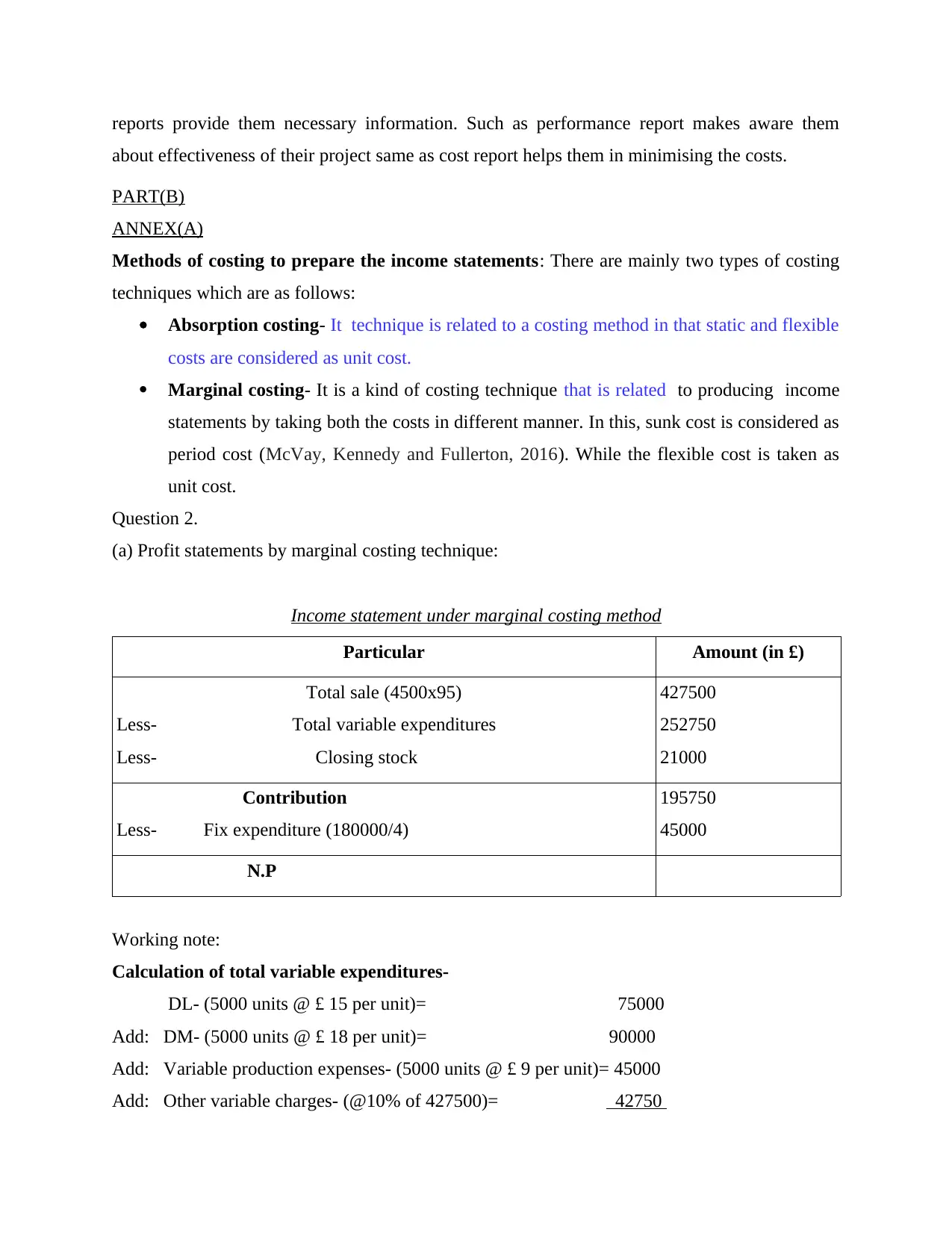
reports provide them necessary information. Such as performance report makes aware them
about effectiveness of their project same as cost report helps them in minimising the costs.
PART(B)
ANNEX(A)
Methods of costing to prepare the income statements: There are mainly two types of costing
techniques which are as follows:
Absorption costing- It technique is related to a costing method in that static and flexible
costs are considered as unit cost.
Marginal costing- It is a kind of costing technique that is related to producing income
statements by taking both the costs in different manner. In this, sunk cost is considered as
period cost (McVay, Kennedy and Fullerton, 2016). While the flexible cost is taken as
unit cost.
Question 2.
(a) Profit statements by marginal costing technique:
Income statement under marginal costing method
Particular Amount (in £)
Total sale (4500x95)
Less- Total variable expenditures
Less- Closing stock
427500
252750
21000
Contribution
Less- Fix expenditure (180000/4)
195750
45000
N.P
Working note:
Calculation of total variable expenditures-
DL- (5000 units @ £ 15 per unit)= 75000
Add: DM- (5000 units @ £ 18 per unit)= 90000
Add: Variable production expenses- (5000 units @ £ 9 per unit)= 45000
Add: Other variable charges- (@10% of 427500)= 42750
about effectiveness of their project same as cost report helps them in minimising the costs.
PART(B)
ANNEX(A)
Methods of costing to prepare the income statements: There are mainly two types of costing
techniques which are as follows:
Absorption costing- It technique is related to a costing method in that static and flexible
costs are considered as unit cost.
Marginal costing- It is a kind of costing technique that is related to producing income
statements by taking both the costs in different manner. In this, sunk cost is considered as
period cost (McVay, Kennedy and Fullerton, 2016). While the flexible cost is taken as
unit cost.
Question 2.
(a) Profit statements by marginal costing technique:
Income statement under marginal costing method
Particular Amount (in £)
Total sale (4500x95)
Less- Total variable expenditures
Less- Closing stock
427500
252750
21000
Contribution
Less- Fix expenditure (180000/4)
195750
45000
N.P
Working note:
Calculation of total variable expenditures-
DL- (5000 units @ £ 15 per unit)= 75000
Add: DM- (5000 units @ £ 18 per unit)= 90000
Add: Variable production expenses- (5000 units @ £ 9 per unit)= 45000
Add: Other variable charges- (@10% of 427500)= 42750
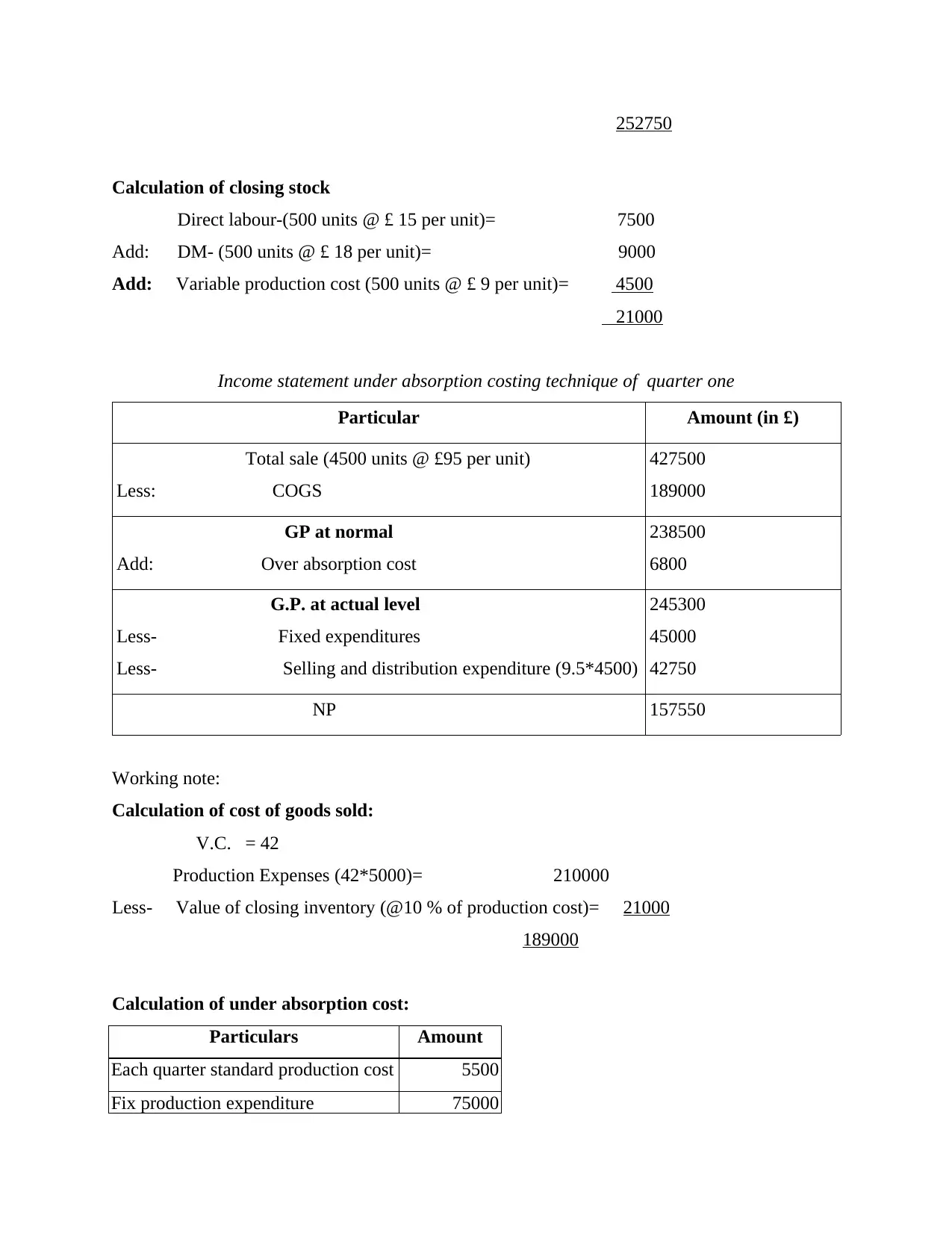
252750
Calculation of closing stock
Direct labour-(500 units @ £ 15 per unit)= 7500
Add: DM- (500 units @ £ 18 per unit)= 9000
Add: Variable production cost (500 units @ £ 9 per unit)= 4500
21000
Income statement under absorption costing technique of quarter one
Particular Amount (in £)
Total sale (4500 units @ £95 per unit)
Less: COGS
427500
189000
GP at normal
Add: Over absorption cost
238500
6800
G.P. at actual level
Less- Fixed expenditures
Less- Selling and distribution expenditure (9.5*4500)
245300
45000
42750
NP 157550
Working note:
Calculation of cost of goods sold:
V.C. = 42
Production Expenses (42*5000)= 210000
Less- Value of closing inventory (@10 % of production cost)= 21000
189000
Calculation of under absorption cost:
Particulars Amount
Each quarter standard production cost 5500
Fix production expenditure 75000
Calculation of closing stock
Direct labour-(500 units @ £ 15 per unit)= 7500
Add: DM- (500 units @ £ 18 per unit)= 9000
Add: Variable production cost (500 units @ £ 9 per unit)= 4500
21000
Income statement under absorption costing technique of quarter one
Particular Amount (in £)
Total sale (4500 units @ £95 per unit)
Less: COGS
427500
189000
GP at normal
Add: Over absorption cost
238500
6800
G.P. at actual level
Less- Fixed expenditures
Less- Selling and distribution expenditure (9.5*4500)
245300
45000
42750
NP 157550
Working note:
Calculation of cost of goods sold:
V.C. = 42
Production Expenses (42*5000)= 210000
Less- Value of closing inventory (@10 % of production cost)= 21000
189000
Calculation of under absorption cost:
Particulars Amount
Each quarter standard production cost 5500
Fix production expenditure 75000
⊘ This is a preview!⊘
Do you want full access?
Subscribe today to unlock all pages.

Trusted by 1+ million students worldwide
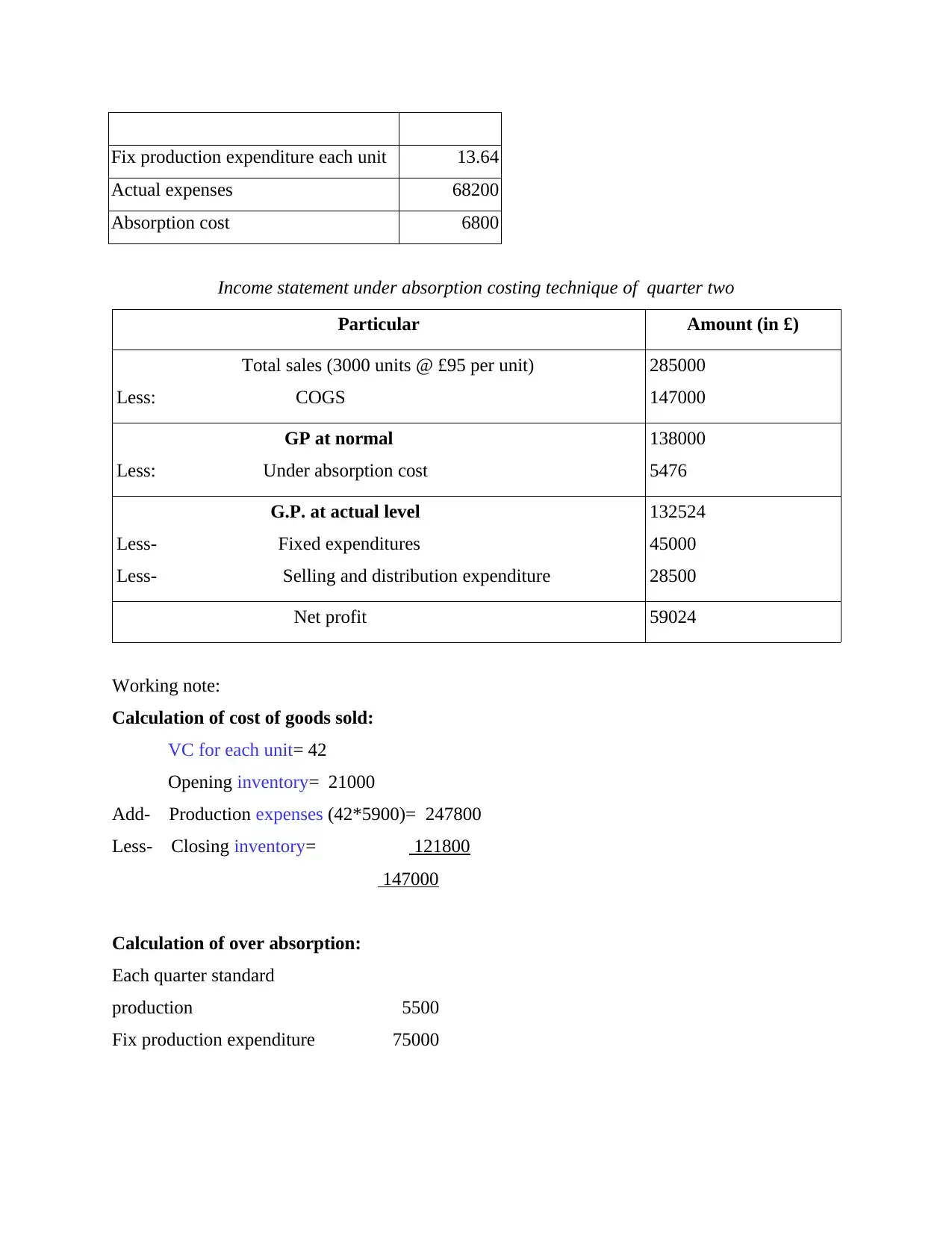
Fix production expenditure each unit 13.64
Actual expenses 68200
Absorption cost 6800
Income statement under absorption costing technique of quarter two
Particular Amount (in £)
Total sales (3000 units @ £95 per unit)
Less: COGS
285000
147000
GP at normal
Less: Under absorption cost
138000
5476
G.P. at actual level
Less- Fixed expenditures
Less- Selling and distribution expenditure
132524
45000
28500
Net profit 59024
Working note:
Calculation of cost of goods sold:
VC for each unit= 42
Opening inventory= 21000
Add- Production expenses (42*5900)= 247800
Less- Closing inventory= 121800
147000
Calculation of over absorption:
Each quarter standard
production 5500
Fix production expenditure 75000
Actual expenses 68200
Absorption cost 6800
Income statement under absorption costing technique of quarter two
Particular Amount (in £)
Total sales (3000 units @ £95 per unit)
Less: COGS
285000
147000
GP at normal
Less: Under absorption cost
138000
5476
G.P. at actual level
Less- Fixed expenditures
Less- Selling and distribution expenditure
132524
45000
28500
Net profit 59024
Working note:
Calculation of cost of goods sold:
VC for each unit= 42
Opening inventory= 21000
Add- Production expenses (42*5900)= 247800
Less- Closing inventory= 121800
147000
Calculation of over absorption:
Each quarter standard
production 5500
Fix production expenditure 75000
Paraphrase This Document
Need a fresh take? Get an instant paraphrase of this document with our AI Paraphraser
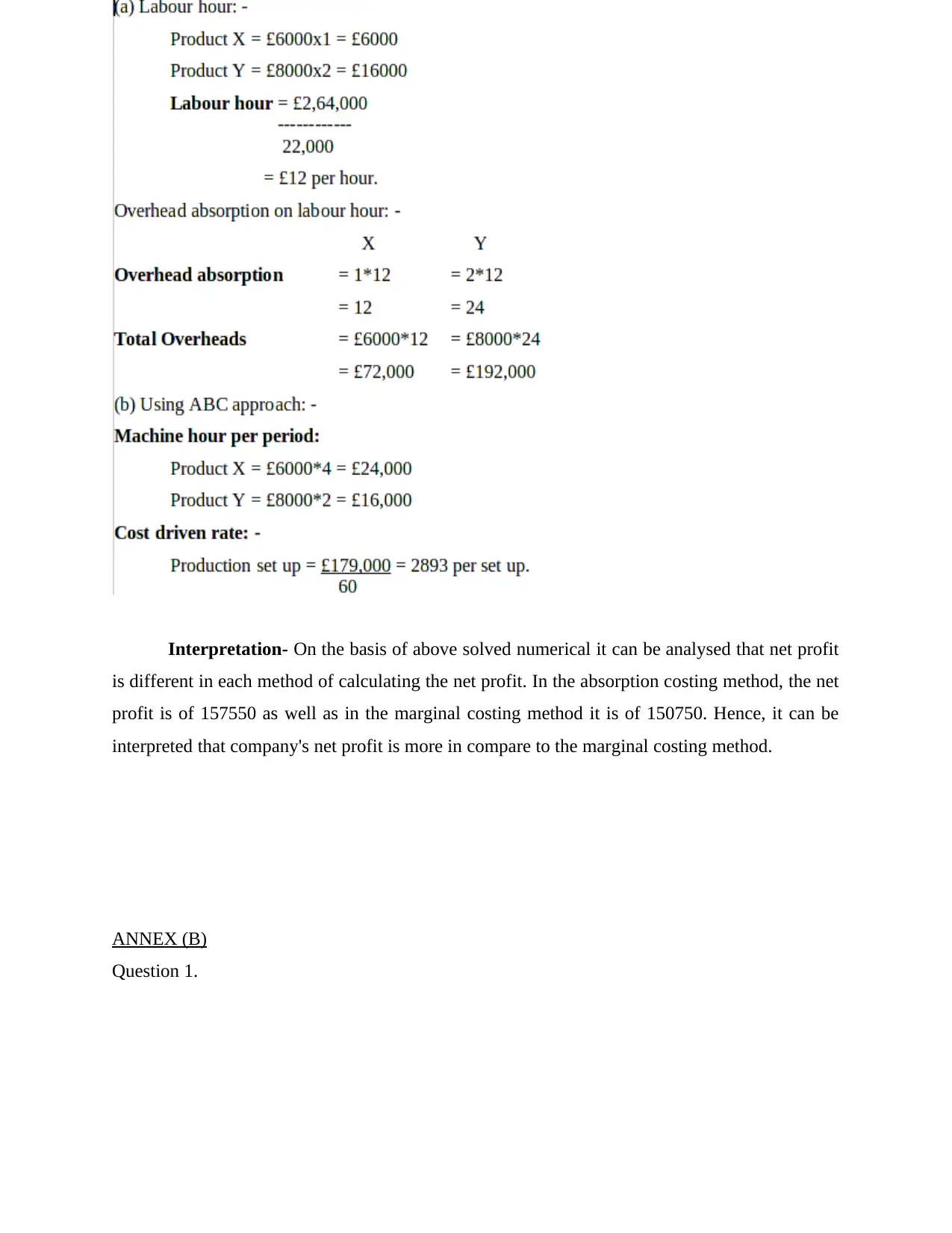
Fix production expenditure
for each unit 13.64
Actual expenditure 80476
Absorption cost -5476
Interpretation- On the basis of above solved numerical it can be analysed that net profit
is different in each method of calculating the net profit. In the absorption costing method, the net
profit is of 157550 as well as in the marginal costing method it is of 150750. Hence, it can be
interpreted that company's net profit is more in compare to the marginal costing method.
ANNEX (B)
Question 1.
for each unit 13.64
Actual expenditure 80476
Absorption cost -5476
Interpretation- On the basis of above solved numerical it can be analysed that net profit
is different in each method of calculating the net profit. In the absorption costing method, the net
profit is of 157550 as well as in the marginal costing method it is of 150750. Hence, it can be
interpreted that company's net profit is more in compare to the marginal costing method.
ANNEX (B)
Question 1.
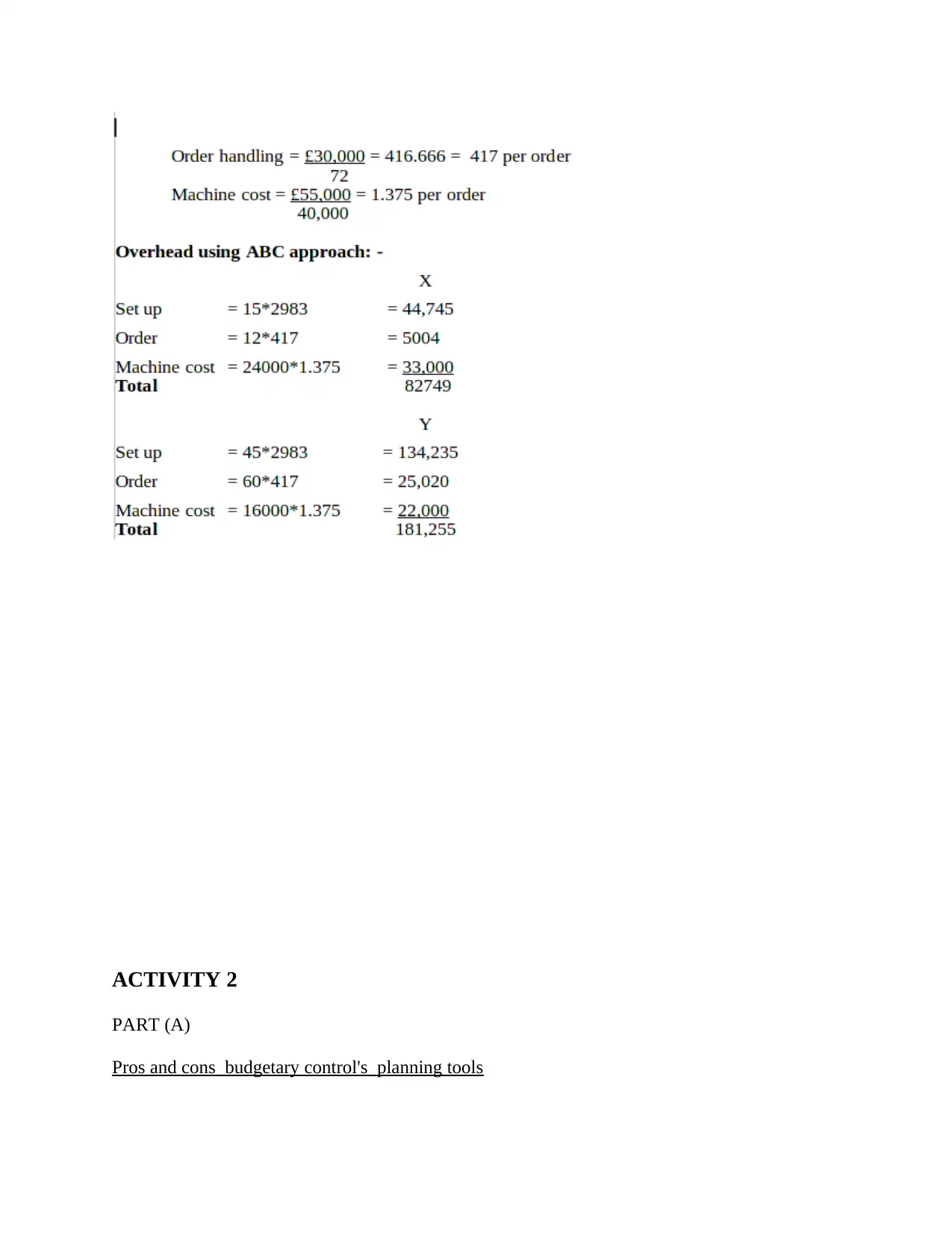
ACTIVITY 2
PART (A)
Pros and cons budgetary control's planning tools
PART (A)
Pros and cons budgetary control's planning tools
⊘ This is a preview!⊘
Do you want full access?
Subscribe today to unlock all pages.

Trusted by 1+ million students worldwide
1 out of 21
Related Documents
Your All-in-One AI-Powered Toolkit for Academic Success.
+13062052269
info@desklib.com
Available 24*7 on WhatsApp / Email
![[object Object]](/_next/static/media/star-bottom.7253800d.svg)
Unlock your academic potential
Copyright © 2020–2025 A2Z Services. All Rights Reserved. Developed and managed by ZUCOL.





